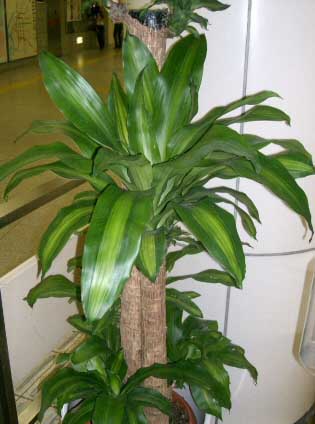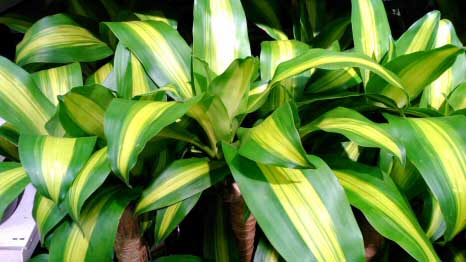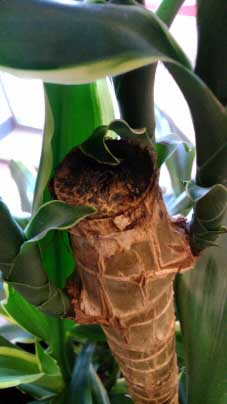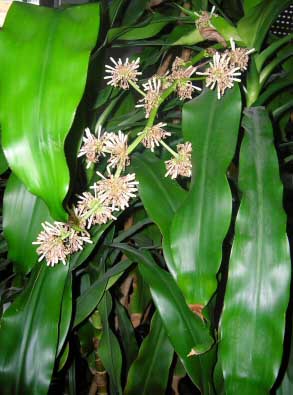





 This very popular houseplant often goes by the name Corn Plant, or by its official Latin name of Dracaena fragrans (impossible to say without sounding French!), it may also be known as Dracaena massangeana. The genus has several other well-known members that we invite happily into our homes, such as Dracaena marginata and Dracaena sanderiana all of which are reasonably content to share our living or office space without a lot of fuss.
This very popular houseplant often goes by the name Corn Plant, or by its official Latin name of Dracaena fragrans (impossible to say without sounding French!), it may also be known as Dracaena massangeana. The genus has several other well-known members that we invite happily into our homes, such as Dracaena marginata and Dracaena sanderiana all of which are reasonably content to share our living or office space without a lot of fuss.
In return for a little bit of care and attention from time to time, the Corn Plant will show off its shiny good looking leaves and removal various indoor air toxins. If you treat it very well, after many years you should get a bold ascent specimen with multiple crowns and the opportunity for it to produce a small spray of fragrant white flowers. Simply beautiful with minimum effort.
It will come either attached and sprouting from a brown textured stem, more correctly known as a Ti Tree, (much like a Yucca does) or the stem will still be "alive" green and resemble that of the Lucky Bamboo.  Either type is suitable for the home so pick the style you like best. In shops you will tend to find one of four popular varieties and cultivars for sale. Again just pick your favorite as they all need the same general care requirements and are all quite easy going.
Either type is suitable for the home so pick the style you like best. In shops you will tend to find one of four popular varieties and cultivars for sale. Again just pick your favorite as they all need the same general care requirements and are all quite easy going.
D. fragrans
The original, with solid green leaves. The original is the least common and of course, it will have its fans but the variegated versions outsell this one massively.
D. fragrans 'massangeana'
By far this is the most commonly found and bestselling Corn Plant cultivar. Distinctive with its sold corn yellow like stripe that runs through the center of each and every leaf means it's easy to see why it is so sought out and why so many people just call this plant Dracaena massangeana and drop the "fragrans". In comparison to the other variegated ones, it tends to have a thinner yellow line and is less distinctive than D. fragrans 'victoria' (see below). The leaves overall also tend to be narrower and longer.
D. fragrans 'lindenii'
This time, the corn yellow is found on the edges of the leaves rather than through the center, which makes it easy to confuse with another houseplant called Dracaena reflexa 'variegata' or the Song of India. The Song of India however is not overly popular as a houseplant (which is why you won't find a profile for it on Ourhouseplants.com) but if you are a fan of the colorings, do try and seek out D. fragrans 'lindenii' instead.
D. fragrans 'victoria' or 'victoriae'
Very similar to 'massangeana' in that the yellow stripe runs through the middle of the leaf, however it tends to have smaller but wider and almost triangular leaves. The Yellow corn stripe is also bolder and more distinctive. Overall this cultivar is probably the most attractive out of the four mentioned here, not just because of the yellow stripe but also the leaf shape is neater and more compact. However it does not grow quite as fast and commercially it can be a pain to find.

Light
Most of those in the Dracaena genus including the Corn Plant do best in light shade or gentle filtered sunlight. The leaves will scorch if too bright and if it's too dark the new leaves will be quite small and the stripe(s) may look quite different to those found on the older ones.
Watering
These plants benefit from a little "drying time" between waterings. So water well and then wait for the top inch of the soil to dry out before watering again. If your Corn Plant is placed in a good spot with reasonable light and warm temperatures, (excluding Winter) you can keep the soil moist at all times. Regardless of your placement, in Winter reduce the watering like you would for almost all houseplants, but the soil shouldn't be allowed to dry out completely.
Humidity
Reasonable humidity is required to prevent blemishes on the Corn Plant's leaves. Misting is a good way to achieve this as well as helping to keep the leaves dust free.
Feeding
Regular feeding in Spring and Summer is recommended. You don't need to feed in Winter or feed newly repotted plants.
Temperature
The Ideal growth range is between 16°C - 24°C / 60°F - 75°F. No lower than 10°C / 50°F and avoid even light frosts at all costs.
Repotting
You only need to really repot every two or three years. But there is no harm in doing it more frequently if you feel it's needed and of course if you have the space and a big enough pot for it.
Propagation
There are three main ways to propagate and typically you can do all three methods at once to create multiple plants. In time the canes will become leggy as the leaf area shifts higher and higher up the plant which means you can:
 Tip - if you can't provide bottom heat, only attempt this in Summer and keep it warm.
Tip - if you can't provide bottom heat, only attempt this in Summer and keep it warm.Speed of Growth
It's quite slow growing, but there is enough new growth to notice its "alive" and draw attention to itself (that might sound wacky, but seasoned indoor plant owners will know what we mean).
Height / Spread
This depends on how tall your ceiling is! To be fair, while natively it could reach 15m / 49ft or more, indoors you will probably run out of large enough pots to allow the plant to ever reach such a size, so expect it to only reach 2m / 6ft after many years.
so expect it to only reach 2m / 6ft after many years.
Flowers
You rarely find flowers on indoor plants from the Dracaena genus, D. fragrans though is the exception. Pay attention when we say the flowers are still not frequent enough to call their appearance "common", but they do occur occasionally if the plant is mature and being treated well. Sprays of small numerous white flowers will come shooting out of the crown and they have a highly fragrant almost sickly sweet scent.
Anything else?
Don't forget to clean the leaves when they get dusty and if your Corn Plant gets too big... Don't be afraid to cut it down to size and start again.
Copyright © www.100flowers.win Botanic Garden All Rights Reserved